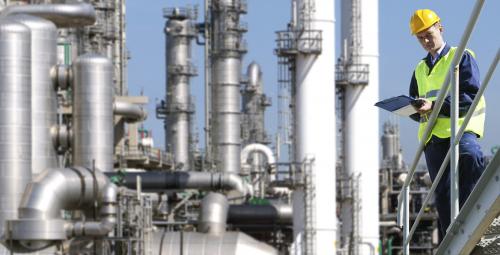Ensuring Efficiency with Reliable Catalyst Hopper Vent Gas Filtration

In today’s highly competitive environment, refinery process efficiency is a critical component in optimizing overall business performance. However, in addition to minimizing downtime, ensuring high quality product output and reducing operating costs, process licensors must also comply with increasingly tougher environmental regulations.
Though it is only a small portion of the refinery’s operation, effective and reliable filtration in FCC catalyst hopper vents can directly influence operational performance by maximizing solids recovery and minimizing environmental exposure.
Unlocking Operational Excellence with Catalyst Loading Hopper Filtration Solutions
As the catalyst is transferred to storage hoppers, it generates a fine dust cloud which must be filtered as the transfer gas is vented. During the continuous filtration process, catalyst fines unavoidably collect on the outside of filter elements, and, over a period of use, build a layer of cake.
To maximize system uptime, advanced filtration systems are mounted directly atop the hopper and employ clean-in-place automatic back-pulsing technology to clean filter elements during operation. This is accomplished by applying several rapid pressurized gas pulses in the reverse direction to a portion of the filter elements, knocking solids free from the element. Solids are discharged from the filter system and returned directly to the hopper below. Since only one quadrant of the filter is cleaned at once, the remainder of the unit is free to operate as required.
The key in designing an efficient system is to balance cleaning effectiveness with the frequency of cleaning cycles and the amount of gas consumed during back-pulse. Again, efficient systems minimize the use of back-pulse gas to keep operating costs in check.
Navigating Regulatory Waters: The Critical Role of Hopper Vent Filters
Hopper vent filters are installed on a nozzle atop FCC catalyst storage hoppers containing fresh or spent catalyst and remove cat fines from conveying gas during loading of hoppers. Effective systems remove catalyst particles from transfer gas vent streams before they are released into the atmosphere, where they adversely affect the environment and can expose refiners to costly fines.
Environmental regulations are affecting the design and operation of FCC processes to reduce flue gases emissions. They are directed at criteria pollutants and air toxic compounds. Criteria pollutants include carbon monoxide, ozone, nitrogen oxides, sulfur oxides, and particulates.
As regulations become more and more stringent, refiners are compelled to pay even closer attention to their plant’s emissions by ensuring the filtration system they choose is effectively removing particulates from gas streams before they reach the atmosphere.
Optimizing Cost and Durability in Filter Design
It stands to reason that the less complex the internal configuration of the filter vessel, the lower the cost – both for manufacture of the unit and its installation. So, the best designed systems limit the number of valves and the amount of interconnecting piping required.
Leading manufacturers offer a variety of filter media, element sizes, configurations and filter grades. The optimum filter element for your application depends on several factors, including your process conditions, solids loading, particle size, gas composition, maximum allowable pressure drop and the characteristics of your particular filter medium. In many process applications, these filters operate at very low pressure or even a vacuum condition while still maintaining the desired gas flow rate.
To ensure durability and longevity of the filter, some of the most advanced filter elements are manufactured using a single layer of sintered metal powder that can withstand high back-pulse pressures and operating temperatures.
Discover Mott’s Expertise in Advanced Filtration Systems
Over the past three decades, Mott’s experienced engineering teams have designed and installed more than 600 high-performance filtration systems in chemical processing, petroleum refining and power generation plants throughout the world. In fact, our technology is in use by nearly all leading process licensors.
Mott designs filtration systems with the smallest footprint possible to minimize floor space and installation costs. And, Mott’s GSV filters systems have been shown to reduce backpulse gas consumption by more than 50%, resulting in significant savings over the long life of the system. Field tests show our filters regularly retain more than 99.9% of particulates in catalyst hoppers.
Mott HyPulse® GSV filter systems are constructed of sintered porous metal and are resistant to mechanical shock and extreme temperatures. They are designed to withstand operating pressures over 3000 psi (200 bar) and operating temperatures up to 1700°F (926°C).
Contact us today to learn more about what Mott can do for your filtration needs.